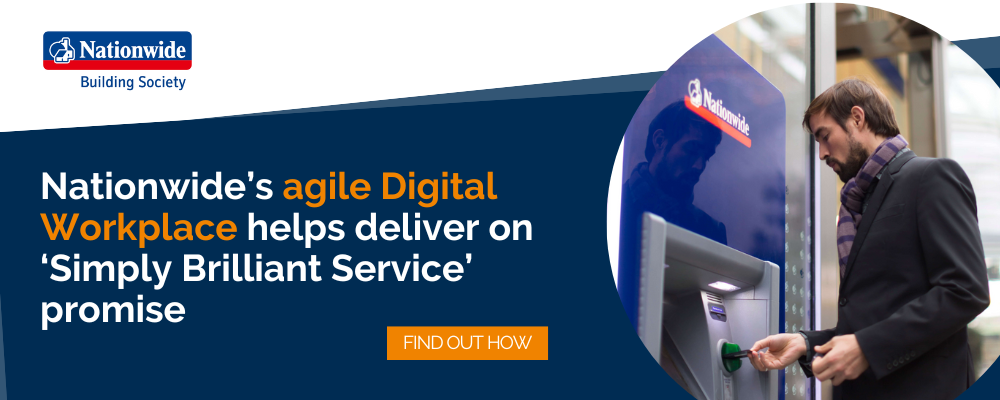![What is a Digital Workplace? [Definition]](https://blog.juriba.com/hs-fs/hubfs/What%20is%20a%20Digital%20Workplace%20%5BDefinition%5D.jpg?width=1600&height=900&name=What%20is%20a%20Digital%20Workplace%20%5BDefinition%5D.jpg)
The Digital Workplace is transforming the way we work. It is an ever-evolving ecosystem of workplace technologies that enables us to communicate, collaborate, and manage content and knowledge more efficiently. In this blog post, we'll explore the history of the Digital Workplace, define it, and explain why Digital Workplace management is becoming more important. So, let's dive in and learn more about the Digital Workplace!
History of the Digital Workplace
The concept of the Digital Workplace has been evolving over the past few decades. In 2009, Paul Miller, founder of Digital Workplace Group, coined the term “digital workspace” to describe a wide-reaching ecosystem of workplace technologies. This new way of working has become increasingly popular with large and small organizations alike as they seek to maximize efficiency and collaboration in their operations.
The digital workspace is an ever-evolving environment and includes a variety of tools and technologies designed to achieve business goals. These include:
- Communications tools and applications for internal communication,
- Collaboration and social engagement platforms for team members to connect,
- Content and knowledge management systems for internal and external sharing,
- Cloud storage tools for document sharing,
- Intranet or portal platforms that provide employees with access to company resources,
- Documentation archives, as well as
- Mobile integration and mobile device management solutions.
Not only does this type of workspace provide increased efficiency through streamlined processes, but it also helps foster better collaboration among team members by providing them with more freedom when it comes to how they communicate and collaborate on tasks. Additionally, having all data stored securely in one place simplifies troubleshooting should any issues arise during project completion or deployment. As a result, the Digital Workplace quickly became an integral part of businesses around the world.
Definition of Digital Workplace
A Digital Workplace is a modern environment that facilitates the collaboration, communication, and productivity of employees. It enables organizations to leverage connected technologies and virtual tools to create an agile workplace where employees can work from anywhere. While there is a consensus on what a Digital Workplace is, there are slight nuances in how certain organizations define the term.
According to Gartner:
"The Digital Workplace enables new, more effective ways of working; raises employee engagement and agility; and exploits consumer-oriented styles and technologies."
VMWare defines a Digital Workplace in a people-focused way:
"The Digital Workplace is an organization's technology-enabled workforce which allows its people to work productively from anywhere on any device at any time. [...] The Digital Workplace experience provides personalized, role-based services as well as the data, applications, and collaboration tools required for employees to work from anywhere, on any device, at any time."
HP defines a Digital Workplace in a more literal sense:
"A Digital Workplace is a virtualized form of the traditional, in-person office environment, where many elements of collaboration and productivity are performed through some combination of digital applications, cloud computing, and other technology."
We at Juriba define the term as follows:
A Digital Workplace provides an organization's technology-enabled workforce with the tools they need to be productive, while enjoying the best digital employee experience. Besides hardware (e.g., laptop), operating system, and data, a Digital Workplace consists of a carefully curated stack of productivity, communication, and collaboration tools so employees can work seamlessly remotely, in the office, or in a hybrid setting.
Providing a Digital Workplace encompasses many different IT components such as hardware refresh, OS upgrades, remote access capabilities, cloud computing solutions, mobile device management solutions, enterprise social networks, analytics tools, and more. All these elements come together to create an efficient working experience for employees by providing them with the right tools and resources they need to do their job effectively. It also helps organizations manage their information securely while enabling better collaboration among team members.
The components of Digital Workplace management
Digital Workplace management means different things for different organizations as it depends on the level of maturity of your IT operations. For us, Digital Workplace management is:
Digital Workplace management refers to consciously creating, maintaining, and upgrading the personalized work environment of employees consisting of hardware (e.g., laptop and peripherals), operating system, data, technology, applications, and the infrastructure supporting the technology that are always-up-to-date, secure, and high-performing to provide the best employee experience.
At its most basic level, Digital Workplace management simply aims to keep up with service requests, IT incidents, patches, security updates, and other changes, as well as OS and application updates and the growing number and types of devices. In other words, keeping the lights on. According to Dan Wilson at the Gartner Digital Workplace Summit 2023, about 80% of organizations surveyed are currently at this level.
Maturing your digital workplace involves consolidating IT resources, management tools, and processes to start shifting from simply managing technology to enabling business productivity and employee engagement through technology. At this next level, organizations focus on increasing IT security and compliance, collaborating with business unit leaders, and building networks of influencers and internal champions to enable this new way of working. IT becomes the agent of enablement.
The ideal state is for digital workplace technology to be a shared responsibility between IT and business units. This means that IT teams will be responsible for providing access to resources, while business units must develop processes that use those resources to digitize work tasks and remove digital friction.
For example, IT can provide access by setting up enterprise social networks, while business units can create processes that facilitate collaboration by having employees post their ideas on these networks or share documents related to their work with each other. By taking this approach, organizations can also leverage technologies to increase employee engagement and satisfaction while also reducing costs associated with managing the digital workplace.
In summary, Digital Workplace management requires organizations to consider both technological requirements as well as process optimization when looking at how they can best use connected technologies and virtual tools for their workforce to be agile enough so that employees can work from anywhere while still feeling confident about their data security. Only then will organizations be able to truly reap all the benefits associated with a successful Digital Workplace strategy.
Why Digital Workplace management is important?
By leveraging digital technologies, tools, and processes, organizations can create a more agile and cost-effective workplace. Digital Workplace management helps to streamline operations and maximize employee productivity while at the same time providing employees with a technology platform that supports their success. The key benefits of implementing a Digital Workplace are:
- Increased employee engagement and satisfaction,
- Improved communication between colleagues,
- Greater flexibility in how tasks are accomplished,
- Better access to organizational resources,
- Improved customer service,
- Reduced costs due to increased efficiency, and
- Enhanced security measures.
With the right implementation strategy in place, companies can reap these benefits while creating an engaging workspace for all employees.
Digital Workplace management also offers organizations a way to improve communication between departments and increase collaboration across teams. By taking advantage of cloud technology, enterprise social networks, analytics tools, and more, employees can share data faster, access resources quickly, and communicate efficiently no matter where they are located. This allows teams to work together more effectively and address issues promptly as they arise.
Another key benefit of Digital Workplace management is enhanced security. With the right tools in place, it’s possible for organizations to protect their data from unauthorized access or malicious attacks while still allowing employees to access what they need when they need it. This ensures that sensitive information remains secure, while still allowing for efficient collaboration between teams.
Finally, Digital Workplace management also enables businesses to reduce costs associated with IT infrastructure as well as employee overhead costs by creating a more flexible working environment where employees can work from anywhere without needing expensive office space or hardware solutions. By taking advantage of these cost-saving opportunities, businesses can realize significant efficiencies while also increasing employee satisfaction levels due to increased autonomy over their work environment.
In conclusion, Digital Workplace management is a valuable tool for any organization looking to stay competitive in today’s marketplace by creating a more agile, collaborative environment with improved communication channels and enhanced security measures all while reducing costs associated with IT infrastructure and overhead expenses related to maintaining physical offices or hardware solutions.
Barry is a co-founder of Juriba, where he works as CEO to drive the company strategy. He is an experienced End User Services executive that has helped manage thousands of users, computers, applications and mailboxes to their next IT platform. He has saved millions of dollars for internal departments and customers alike through product, project, process and service delivery efficiency.

























